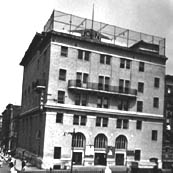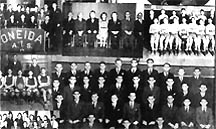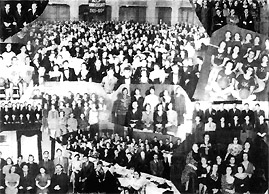|
In 1920, at the one hundred and thirty-seventh convention of the Diocese (Episcopal) of New York, the Bronx Church House was sold to the Bronx Jewish Institute for $177, 500. As was mentioned, the demographics of the neighborhood changed dramatically from 1900 to 1920. Nine out of ten
families were now Jewish.
There was a "Bronx Y" or a Young Men's Hebrew Association at Franklin Avenues and 169h St., but even with the First World War taking its men, the Y was growing beyond its capacity. In 1920 the Bronx Jewish Institute took over the building at 1511 Fulton Ave., and in 1922 by the Jewish Education Association, only to heap up huge debt for both organizations.
It was at this point that the Institute became part of a federation with the Y and the Bronx Y moved into its quarters on Fulton Ave. The building would remain a YM-YWHA for twenty-eight years until 1950. In the 1930's, with the Depression, the Y struggled. Membership dropped and activities had to be limited. By the 1940's America was gearing up for World War 11. Active membership at the Y once again dwindled as men and women went off to war.
The Y, in those days, was described as a "stately" building, with a basement swimming pool and a roof solarium. A full range of activities was available to the residents around the Bronx. These included involvement in various clubs, a Y newsletter, the "Observer", and the Thalian Guild, a
theatrical group which performed many of the plays of the day. One of its members was Moss Hart. The Y had Surprise Lake Camp and Camp Wel-Met for its youth each summer.
The Y's Talmud Torah was integral in fostering its religious teachings, aandd thee Synagogue would hold as many as 1,500 people on High Holy Days. A woman, who belonged, reminisces "There was an indoor track surrounding a full-sized basketball court on the top floor. A large synagogue was on
the ground floor. The men occupied the seats on the main floor and the women sat in the gallery. There were no pews attached to the floor. The men sat on folding chairs, which when folded away, left the floor open for dancing on Wednesday and Saturday nights for young people. I met the young
man who would be my husband at a Thanksgiving Day dance at the Synagogue." In his book "The Catfish Man", by Jerome Charyn, he recounts his encounter with gangs in Crotona
Park while he and his brother crossed through the park to get to the Y. It was 1949 and he and his friends were serious weightlifters, honinii their muscles in the weight room off the curved track above the gym floor. In 1950, the Crotona Y moved to the Grand Concourse. The stately building
described when the YM-YWHA first moved to 1511 Fulton Ave., had now become a "facade of crumbling bricks".
|


